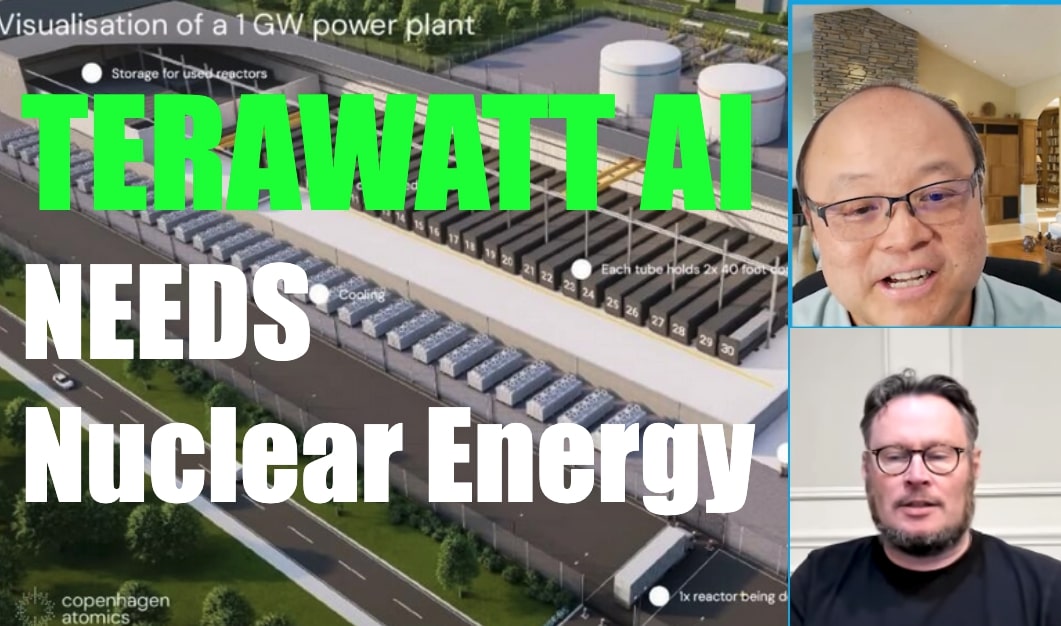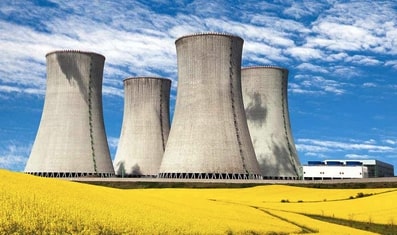Now Reading: CEO Copenhagen Atomics – Terawatt AI Needs Nuclear Energy
-
01
CEO Copenhagen Atomics – Terawatt AI Needs Nuclear Energy
CEO Copenhagen Atomics – Terawatt AI Needs Nuclear Energy

The AI data center wave has an insatiable demand for energy. Energy, AI GPUs and data can be scaled to give more intelligence and can lead to superintelligence.
This has become globally strategically important. The US is shifting to pro-nuclear energy policies. AI will leverage all energy sources starting with natural gas but also scaling nuclear energy, solar and batteries.
There will be a need to double or triple the amount of world energy by around 2050.
TSMC (Taiwan Semiconductor) has projected (april 2025) that they will increase the volume AI GPUs by ten times. If each data center will need 2 kilowatts to power each of those chips, then we will go from 10 GW per year to 100 gigawatts per year to power the GPUs sold by TSMC in one year. The AI PCs and other inference systems will also increase the energy demand.
TSMC is making most of the AI chips and their forecast us showing AI demand going over 100+ Gigawatts per year by 2030. If the AI chips stopped scaling in 2030 then there would be need for over 1 Terawatt from production in the 2030s. If AI demand continues to increase we will need many Terawatts.

Copenhagen has plans to mass produce its nuclear power to meet this huge AI energy demand.



Assumptions about the Terawatt Needed for the AI Future
We are going to assume that this 1 terawatt is for AI training. Therefore it must be available in one or two countries and at most in 10 locations. Because it is for AI training, we would prefer low
cost and base load (always on).
AI data centers are expensive, therefore ideally they need to run all the time. But 100% capacity factor is expensive, therefore we are going to assume that the data center will accept a lower
capacity factor, if the price is lower:
● If capacity factor is 80%, price should be 66% of the 100% capacity factor price.
● If capacity factor is 50%, price should be 30% of the 100% capacity factor price.
It will take close to 10 years to grow the factory capacity of the chip’s production to reach a level where 1 terawatt of power would be needed for the data centers. Therefore we assume we have 10 years to build out the electricity capacity.
Today the whole world produces 20 TW of all types of energy and 3.5 TW of electricity. The global energy market has been growing for more than 100 years, thus this will only require a slightly higher growth rate and may therefore only require slight growth in prices if we do it right. But on the other hand, if we put too much pressure on a market which has some components that limit the growth factor, then that technology or market may have a large price hike.
Technology overview:
The 3 largest hydro dams in the world produce 22 GW, 14 GW and 13 GW respectively. And there is not much more hydro power which can be developed on a large scale. Thus we will dismiss hydro power as a primary solution although hydro power is usually low cost and perfect as backup for wind and solar.
Coal, oil and gas already provide more than 5 TW of energy each and can somewhat easily be transported. Thus they are all possible options. They can provide a capacity factor above 95% and are assumed to have the following electricity prices if the AI data center is located convenient for the fossil fuel source.
● Oil ~ 90 USD/MWh (CAPEX: $1T per TW)
● Gas ~ 50 USD/MWh (CAPEX: $1T per TW)
● Coal ~ 30 USD/MWh (CAPEX: $2T per TW)
All 3 fossil fuels are 100 year old technology and can easily be scaled to make 20% more in 10 years time, without a major price hike. Coal power plants are generally twice as expensive to build as gas power plants. But because coal is generally cheaper than gas per unit of energy, then these plants make lower cost energy in the long term. But for AI data centers, the technology may change in 10 years and we are not interested in a coal power plant that lasts 50 -80 years. We just want the cheapest and fastest. Which is gas in this case.
Wind and solar each provide 28 GW and 20 GW globally in 2024, and they both have capacity factors below 50%. Thus they are unlikely to be able to scale to 1 terawatt even if combined, wind, solar, batteries and hydro. If they could scale, the price would likely be higher than coal and gas.
This is also why the majority of electricity in the world is made from coal and gas and why coal and gas has been growing significantly faster than wind and solar in the previous 10 years. We conclude that wind and solar could provide some of the 1 terawatt, but they are unlikely candidates to carry the bulk of the generation capacity. They also take up a lot more space than all the other options, land is expensive and may further limit where we can put the data center.
I, CEO Thomas Jam, believe that it is highly unlikely that fusion will be able to provide commercial fusion reactors within the next 10 years, therefore this is ruled out.
Nuclear energy is the most difficult to estimate, because the entire world only provides 1 TW of energy from nuclear today and nuclear has a reputation for being slow to build. But there is clearly enough uranium in the world to build out additional 1 TW of nuclear power.
Old nuclear power plants that were built before Chernobyl and Fukushima can generate electricity below 30 USD/MWh and have 90% capacity factor and sometimes higher. However very few nuclear power plants have been built in the last 30 years and many of those that did get built in the USA and Europe were very expensive and slow, with electricity prices well above 100 USD/MWh.
There are a number of new nuclear power technologies being proposed. But none of them have been built and the cost and build time are not proven. None of these solid fuel uranium reactors seems to be able to get the price below 50 USD/MWh, most of them are expected to be above 100 USD/MWh.
Copenhagen Atomics thorium reactors:
Copenhagen Atomics (CA) has invented a new type of nuclear reactor which runs on thorium instead of uranium. Thorium is 1000 times more plentiful than Uranium-235, which is what all the other nuclear power plants predominantly run on. Uranium fuel is approximately 1000 times more expensive per kWh than thorium. Copenhagen Atomics thorium reactors also need spent nuclear fuel as their kick starter fuel or alternatively they need uranium as their kick starter fuel. But since you end up with more uranium than you need to start the process, it is merely used as a catalyst in this reactor type. You can sell it in the end and likely make more money than it cost up front.
Copenhagen Atomics thorium reactors have approximately the same size as a 40 foot shipping container and can easily be mass manufactured. CA proposes to make more than one reactor every day in the beginning. Each reactor unit generates 42 MW of electricity. Thus 10,000 units would generate 400 GW(e), likely with 96% capacity factor.
Copenhagen Atomics estimates the electricity price to be 20 USD/MWh. Each reactor unit costs $50M including the fuel. CAPEX: $2.5T per TW fuel included. Thus in the long term you have more price security and much lower electricity cost.

Brian Wang is a Futurist Thought Leader and a popular Science blogger with 1 million readers per month. His blog Nextbigfuture.com is ranked #1 Science News Blog. It covers many disruptive technology and trends including Space, Robotics, Artificial Intelligence, Medicine, Anti-aging Biotechnology, and Nanotechnology.
Known for identifying cutting edge technologies, he is currently a Co-Founder of a startup and fundraiser for high potential early-stage companies. He is the Head of Research for Allocations for deep technology investments and an Angel Investor at Space Angels.
A frequent speaker at corporations, he has been a TEDx speaker, a Singularity University speaker and guest at numerous interviews for radio and podcasts. He is open to public speaking and advising engagements.























